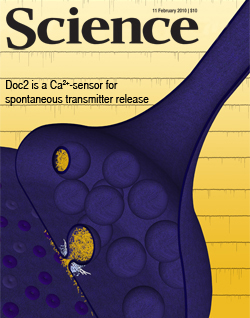
The CNCR team of Sander Groffen and Matthijs Verhage discovered that the Doc2b gene is a Ca2+-sensor responsible for triggering spontaneous release events. Their findings are published as a full length article in the accelerated online version of Science on Febr 11th, 2010.
Fusion of synaptic vesicles in the synapses of the brain occurs in 3 different phases, either tightly coupled to action potentials (synchronous release), immediately following action potentials (asynchronous release) or as stochastic events in the absence of action potentials (spontaneous release). The Ca2+-sensors for synchronous release have been identified about a decade ago (synaptotagmin genes). While spontaneous release events were first identified more than 50 years ago, the mechanism that induces their release has remained elusive.
CNCR researchers Sander Groffen and Matthijs Verhage together with their collaborators at CNCR and colleagues in Cambridge, UK, have now discovered that Double C2 domain (Doc2) proteins act as Ca2+-sensors to trigger spontaneous release in hippocampal and Purkinje cell synapses.
Although Doc2 proteins are cytosolic, they function analogously to synaptotagmin but with a higher Ca2+-sensitivity and superior in vitro fusion-efficiency. Doc2 proteins bound to the macromolecular protein complexes that drive fusion (SNARE complexes) in competition with synaptotagmins. Thus, different classes of multiple C2 domain-containing molecules trigger synchronous versus spontaneous fusion, which suggests a general mechanism for synaptic vesicle fusion triggered by the combined actions of SNARE proteins and multiple C2 domain-containing proteins.
First author Sander Groffen worked on this project for many years, initially by characterizing Doc2’s exceptional Ca2+-sensitivity and the biological consequences of the conformation changes induced by Ca2+, which induces the protein to translocate to the membrane. Sander also generated the mutant mice that now have formed the basis of the discovered link between Doc2 proteins and spontaneous release. During the last year, Sander was supported by a team of physiologists at CNCR, Natalia Goriounova, Niels Cornelisse, Rocío Díez Arazola and Arthur de Jong who worked jointly on the cultured neurons from the mutant mice to test different Doc2 mutations in vivo. In parallel, their colleagues in Cambridge, Sascha Martens and Harvey McMahon, characterized the fusogenic properties of Doc2 in in vitro experiments and documented the competition between Doc2 and Synaptotagmin for SNARE-complex binding.
Last author Matthijs Verhage is very happy that this project finally reached such an important and visible conclusion: “I have studied these genes ever since I cloned them (Verhage et al, Neuron, 1997) and it took a while before we understood where to look. Key events were that Sander found that Doc2b is activated by such minute changes in Ca2+-levels in the cell and later, while our colleagues in Cambridge showed that Doc2b is a lot more powerful in triggering in vitro membrane fusion than other molecules currently known to be involved in fusion. I am also proud and relieved that the paper is now accepted in Science. After completion of the review process at Science you really feel you have convinced the whole world of your conclusions‚.
This discovery makes it now possible to start investigating the importance of spontaneous brain activity for various tasks performed by the brain, such as learning and memory. The researchers also started to investigate if genetic mutations in Doc2 genes may be involved in nervous system diseases.